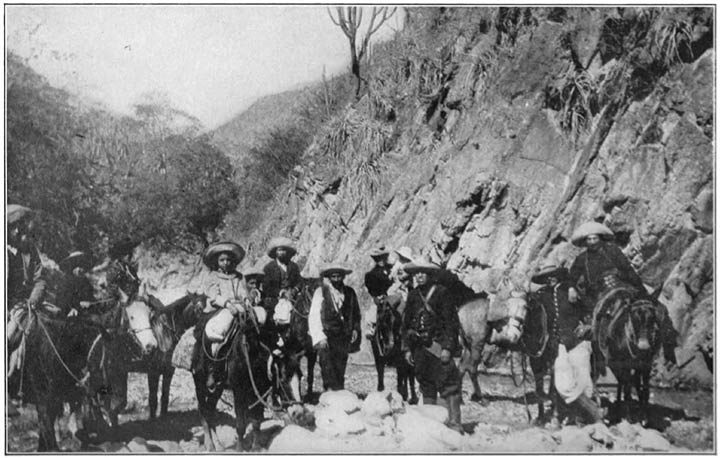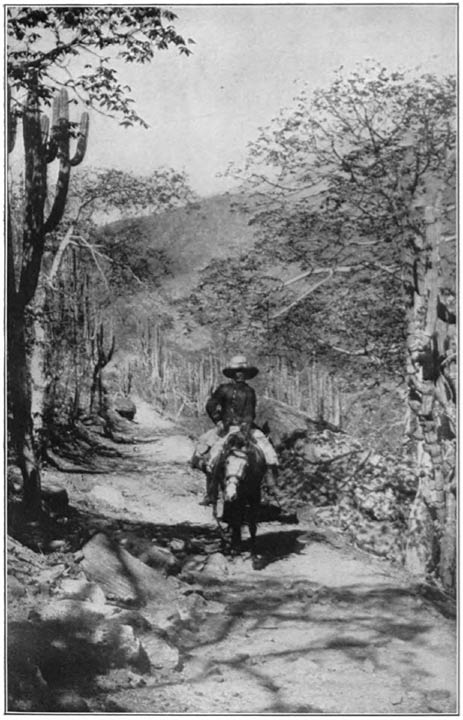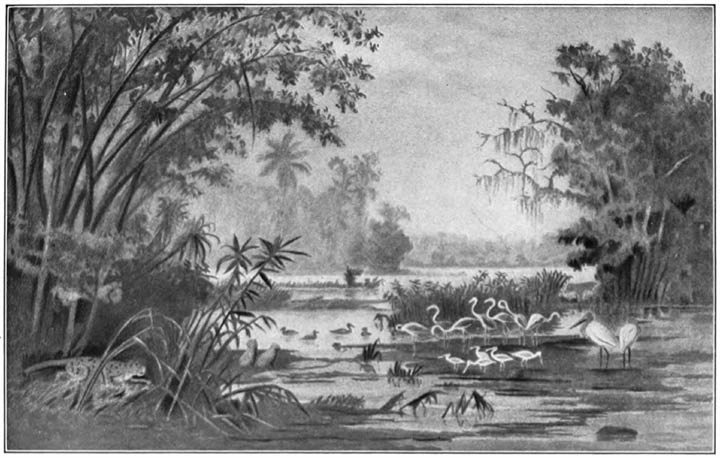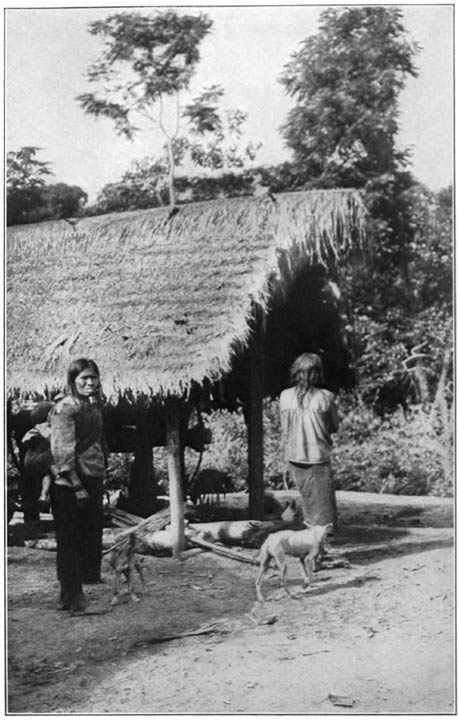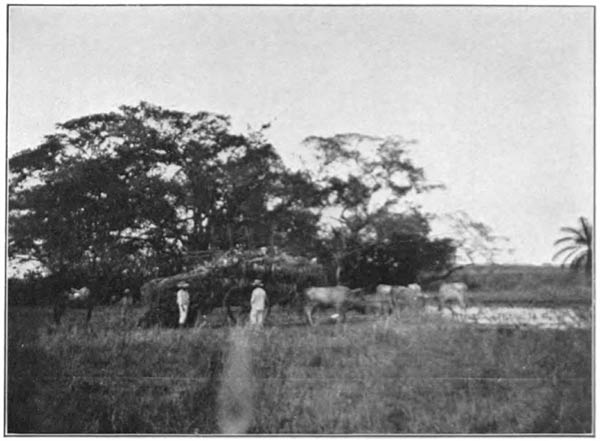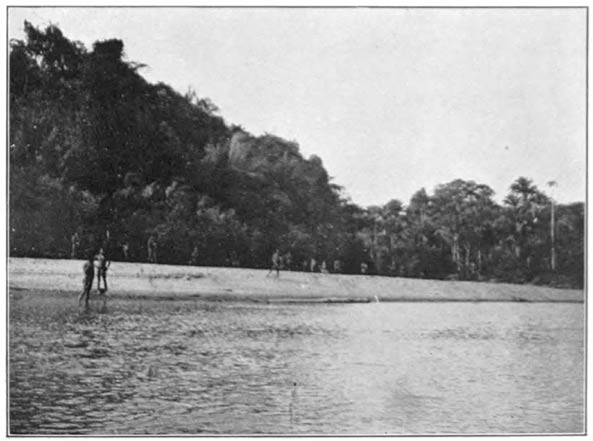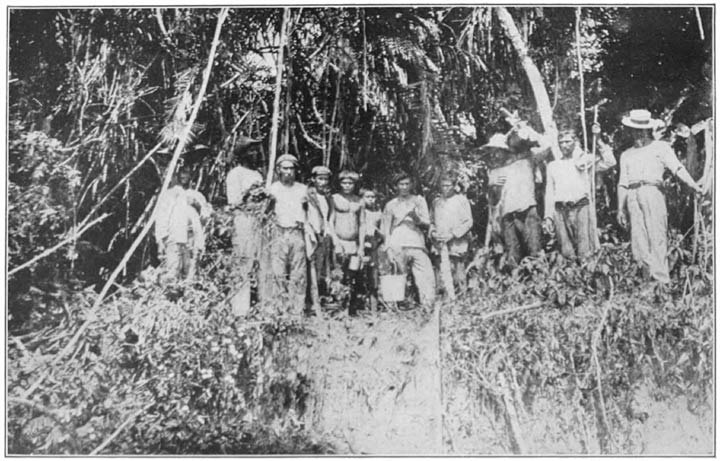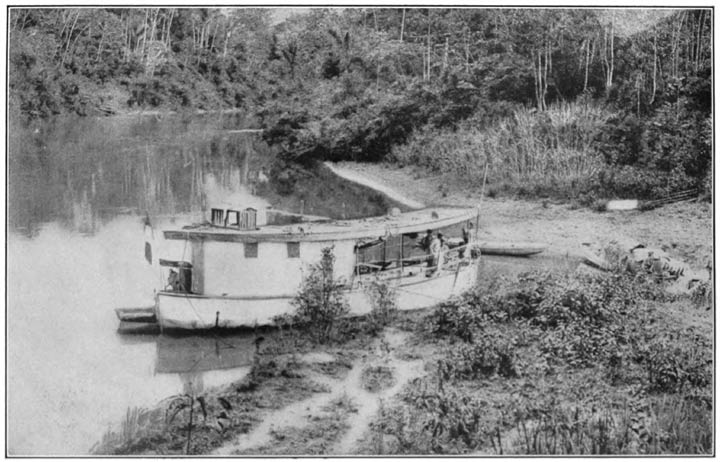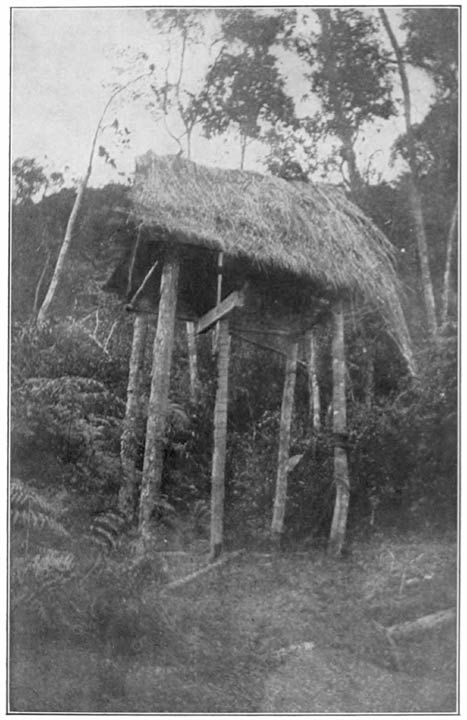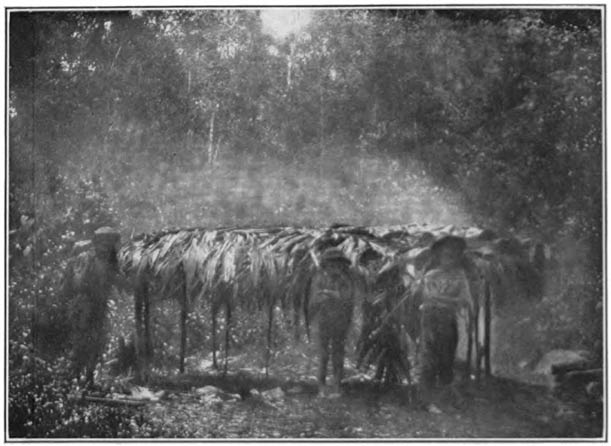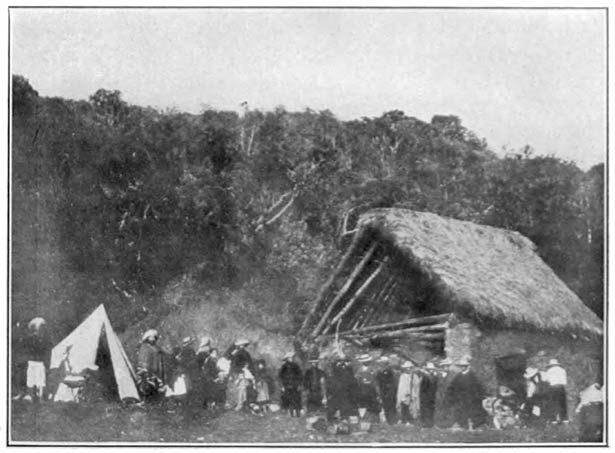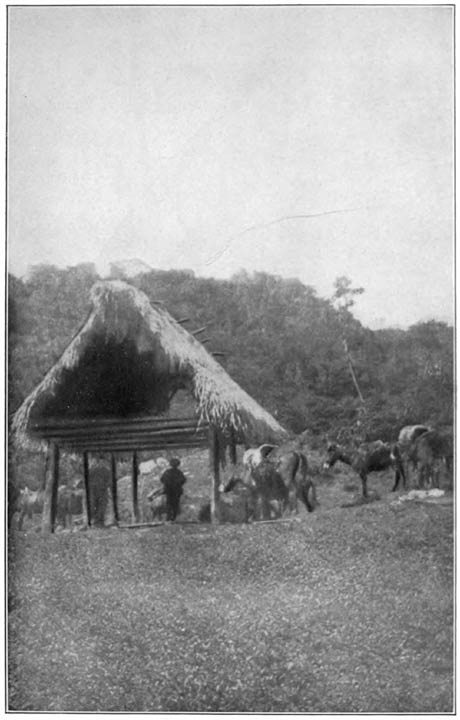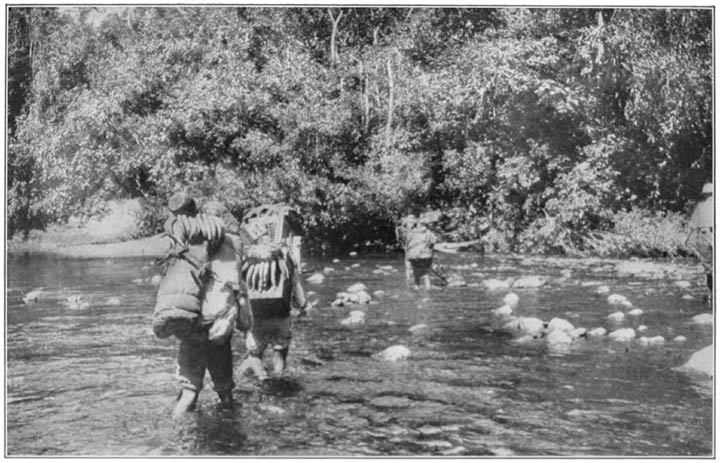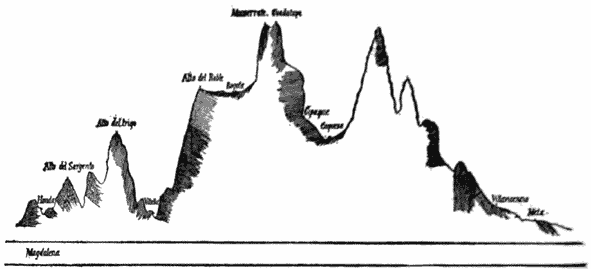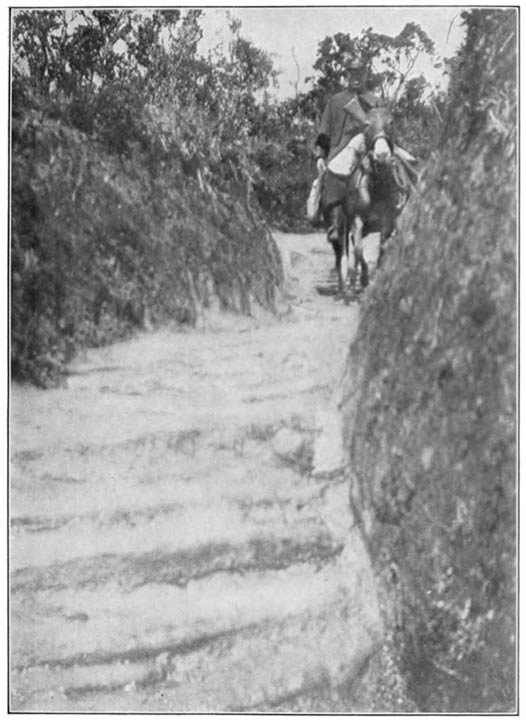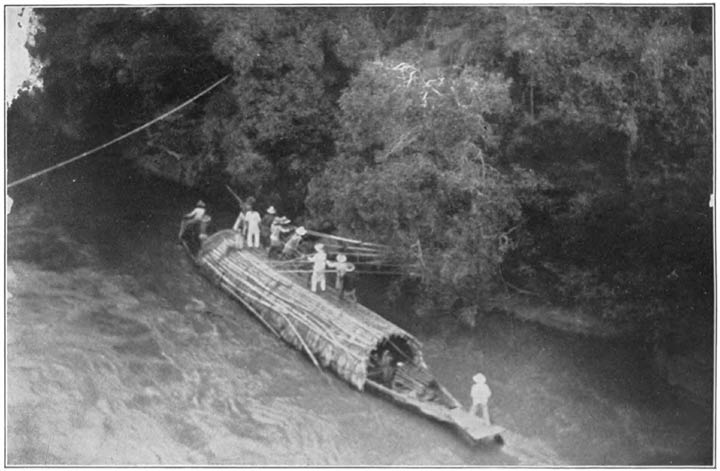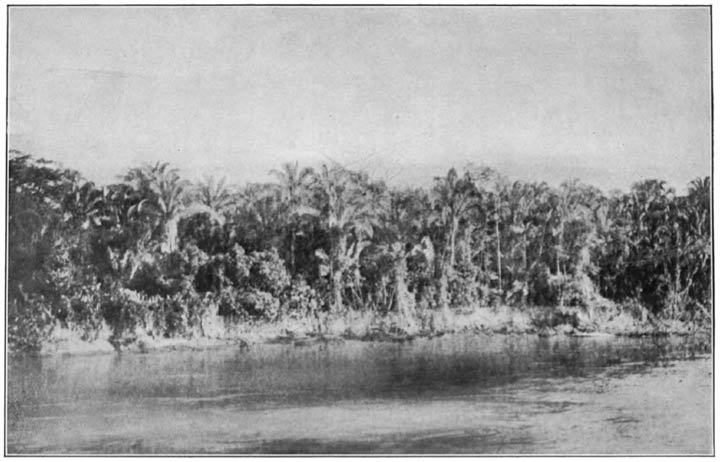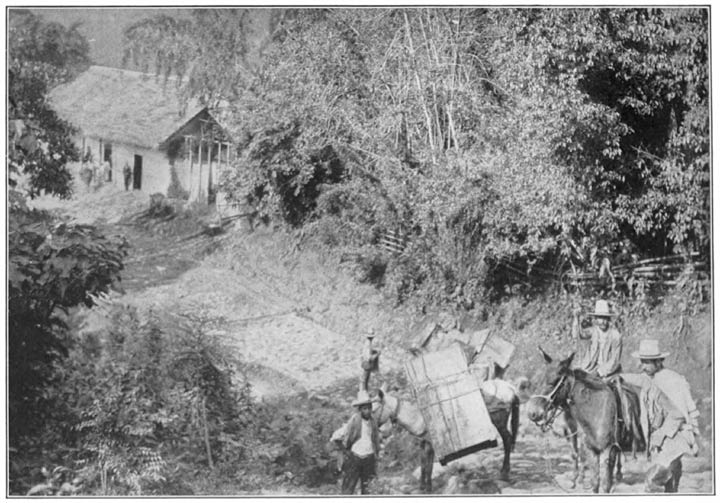No sooner had our launch reached the landing place,
than we bounded ashore, eager for information about our mules and their
drivers. We asked the sable matron who, with her equally sable
daughters, waited at the brink to greet us, if the mules had come. She
replied laconically, “No, Señor.” “Have you
heard anything about them?” “No, Señor.”
“Is there anyone here,” and I glanced at the swarthy youth
hard by, “that would be willing, if well rewarded, to go forward
and hasten the arrival of men and mules?” “No,
Señor.”
What was to be done? We could not continue our journey alone and
afoot, even if we were disposed to leave our baggage behind us. And it
soon became evident that it would not be safe to remain long at
Barrigón. There was but one rude hut there, and that was
surrounded by mud and pools of water covered by “Spawn, weeds and
filth
and leprous-scum”—certainly not a very inviting place to
abide any length of time.
Besides, the family had nothing to eat, at least they said they had
not, except a few platanos, and these they required for their own use.
We had almost exhausted the supply we had brought from Trinidad, and
the little that was still left, we intended for our three-days trip to
Villavicencio. We were not sure that we could get anything on the way,
and we did not wish to run any risk of being without food where it
might be most needed.
Something had to be done, and that quickly, if we did not wish to
expose ourselves to the pangs of hunger and the danger of fever in that
filthy, miasmatic hole. In the dry [196]season, we might return to
Cabuyaro, where we could secure horses or mules, and go thence to our
next objective point, Villavicencio. During the rainy season, however,
this was impossible. We had been told the night before, that several of
the caños and rivers between Cabuyaro and Villavicencio were
quite impassable, as there were neither bridges nor ferries, and that
the currents were so swift that it was quite out of the question for
man or beast to cross them by swimming.
We were certainly in a quandary, if not in a very serious
predicament. It was useless to go backwards, unless we wished to return
to Orocué, and thence to Trinidad. Even if we returned to Orocué,
we could not get a steamer down the river for several months, and to
make the long trip to Ciudad Bolivar in a bongo was not to be thought
of. We were confronted by the first really grave difficulty of our
journey, and when we considered all the circumstances, it was enough to
depress the stoutest heart.
“But why had not our men and mules arrived,” we asked ourselves
time and again? Our telegram
ordering them had been received and satisfactorily answered. Just
before leaving Orocué we had sent a second telegram advising our
vaqueano—guide—when he should meet us but we had not
awaited a reply, taking it for granted that there would be no hitch in
our plans. It now occurred that we had acted unwisely in not waiting
for a response to our second telegram, so as to be sure that it had
been received and was properly understood.
The telegraph line to Orocué had only recently been put
up—just a few weeks before our arrival there—and had never
been in satisfactory working order. In fact, owing to a break in the
wire, which lasted a fortnight, we had not been able to get into
communication with Villavicencio—the place whence our mules were
to come—until a few days before we started for Barrigón.
Might there not have been another interruption in the line after we
sent our second message? And did this message ever reach [197]its
destination? It is true that a week had elapsed since our departure
from Orocué, and, if the line had been severed, it might have
been repaired.
But then again this was far from certain. The wire passed through
dense and interminable forests—where there were no roads of any
kind—and it might require several days to reach the break after
it was located. And then after our vaqueano got our telegram it would
require three days for him to go from Villavicencio to Barrigón,
supposing that he had the mules and saddles in readiness. If they were
not ready there would be another delay in starting. Altogether the
outlook was far from reassuring. Our animals and men might arrive at
any hour, and then again we might be obliged to wait for them for
weeks.
While occupied in these far from comforting reflections, we
remembered that the mail from Bogotá to Orocué was due.
The men who would bring it would also bring a certain amount of freight
for various points on the Meta. Here, then, was a ray of hope. If our
own men and animals should fail us, we might be able to prevail on the
mail carriers to give us the necessary means of transportation for
ourselves and baggage. This consideration tended to relieve somewhat
the suspense which was the most unpleasant feature of our hapless
situation. We resolved, accordingly, to take a more optimistic view of
things, and to trust to our star which, so far, had ever been in the
ascendant.
What had greatly contributed to the gloominess of the outlook on our
arrival at Barrigón was the thought that we should be obliged to
leave our launch—where we were so comfortable—for the
dismal, steaming pest-hole on the river’s bank. We did not for a
moment think of asking for shelter in the filthy shack occupied by the
negro family. That would be tantamount to courting
paludismo—malarial fever—in its worst form.
Fortunately, we had a good tent with us, and in this we could be
shielded from sun and rain, and, at the same time, escape some of the
unsanitary [198]features that rendered this spot so forbidding
and dangerous. It was really the first place that we had yet visited
from which we instinctively shrank and from which we wished to depart
at the earliest possible moment.
While thus preoccupied and devising ways and means for rendering our
enforced detention at this spot as endurable as circumstances would
permit, our captain, God bless him! observing our distress, came to us,
and with a kindness and courtesy we can never forget, said,
“No se preocupen, Señores, la lancha
quedará aquí hasta que vengan las bestias.” Do
not worry, gentlemen, the launch will remain here until the arrival of
your animals.
What a relief this kind and considerate act was—performed when
and where it counted for so much to us—only those can realize who
have been placed in similar situations. Everything was now as well
provided for as might be, except food. Where that was to come from was
a mystery, as we did not wish to draw on the very limited supply we had
brought with us.
Our first meal consisted of plátanos—some boiled and
some fried—with a cup of black coffee. I had never eaten a dozen
bananas in any form before coming to South America, but I gradually
became accustomed to them, although I never relished them. Here,
however, there was nothing else in sight, except two or three ducks
that were quacking about the green, miasmatic pools that surrounded the
negro shanty. We endeavored to purchase these, but, although we offered
the old dame several times what they were worth, she would not part
with them. No African ever held on more tenaciously to his fetish or
rabbit-foot than did this swart Ethiopian hag of Puerto Nuevo to her
prized webfeet.
For our dinner we fared better. Fortunately and quite unexpectedly,
someone succeeded in landing a large and delicious fish, which was
quite sufficient to furnish a meal for ourselves and crew. A new source
of food-supply was now indicated, but try as we would, it was
impossible to [199]catch another fish—large or small. The
impetuous current of the muddy river was decidedly adverse to our
rising piscatorial hopes. But we determined not to worry on account of
our lack of success as anglers. “Sufficient for the day is the
evil thereof.” Providence, we were sure, would provide for the
morrow. Probably our men and mules would arrive. If not, the mail
carriers would undoubtedly come, and then no Deus ex machina
would be necessary to extricate us from our embarrassing situation.
A dreary day passed and a more dreary night. What with the suspense
and the lack of proper food, and the confinement to a disagreeable spot
in the impenetrable forest, our position was such as not to encourage
slumber by night or rapturous admiration of tropical flora during the
day. Nevertheless, we still instinctively felt that relief would not be
long in coming.
The second morning we had our usual desayuno of black coffee and
plátanos. And to our amazement, there was added to this simple
fare a fine roast chicken. Where did it come from? We had seen no
chickens anywhere about the premises, and could not have been more
surprised if it had dropped from the blue sky. I asked the captain, and
he quietly replied with a smile, “Un poco de diplomacia. Nada
mas.” A little diplomacy. Nothing more. Ever considerate
about our comfort and needs, he had instituted a search for provisions,
and learned that the la vieja—the old woman, as he called
her—had some chickens concealed not far from the house, and,
whether by persuasion or threats, he would not say, he induced her to
part with one of them, and intimated that the same diplomacy he had
employed in getting the first, would, if necessary, avail in securing
others. The outlook was still brightening, and we now felt more than
ever that our deliverance was near.
Shortly after midday, while we were taking our usual siesta in the
launch, we were suddenly startled by an unearthly noise. All the dogs
and whelps of the place and all the “curs of low
degree”—and there were many of [200]them—began to bark at once. And then in
the forest near by there was such shouting and screaming on the part of
men and boys, accompanied by the neighing of horses and the braying of
mules, that it seemed that a troop of guerrillas was bearing down upon
us. Never before had we heard anything like it, except possibly a Sioux
or Navajo war whoop. They seemed to desire to frighten us to death
before attacking us vi et armis. But no music could have been
more grateful to our ears than were those discordant notes emitted by
man and beast. We knew at once what it all meant, and, almost before we
could reach the top of the bank, our animals and men were all gathered
in the small free space in front of the cabin, and with them were the
bearers of the Bogotá mail. There were about thirty mules and
horses, and more than a dozen men.
We had telegraphed for mules only, as we did not think we should be
able to get horses, but to our delight we found that we were to have
two good saddle horses for our personal use, besides the mules destined
for our baggage. As, however, both men and animals needed rest, after
their long tiresome trip from Villavicencio, it was deemed best to
defer our departure until the following morning. The animals were then
turned loose to browse on whatever they could find to appease hunger,
and their masters were soon ensconced in their hammocks, slung wherever
they could find a suitable place for them.
It was arranged with our vaqueano that we should all be ready for
our journey across the llanos de madrugada—at early
dawn—the following morning. We had a long day’s ride before
us, as the nearest stopping place, where we could hope to find food and
shelter, was at a place called Barrancas, where was the house of the
owner of a large hato—cattle farm.
Bright and early, then, the next morning, our peons and vaqueano
were busy saddling our horses and packing our baggage on the backs of
the mules. The mail bongo from Orocué—which had left that
place ten days before we did[201]—arrived a few hours before
our departure, and all mail matter was hurriedly put on the backs of
other mules by those in charge of the mail destined for Bogotá
and intervening points.
It was not without a pang that we bade farewell to our devoted crew,
who had done so much to render our voyage on the Meta and Humea as
pleasant as it was memorable. From the ever-courteous and thoughtful
captain to our good-natured and obliging Guahibo, we were always the
recipients of delicate attentions of every kind. We might travel far
before again meeting with men so kind and so sympathetic as were those
four whom it was our good fortune to meet in an isolated village of
far-off Colombia. “God bless you all!” we said in parting.
“Nothing is too good for you.”
During the first hour after starting we had to struggle through what
the natives call the montaña. It had nothing mountainous
about it, as the name would seem to indicate, but was a dark, nearly
impervious wood almost on a level with the waters of the Humea. In the
dry season, I doubt not, the path through this forest would present no
difficulty, but during the rainy season it was next to impassable.
Everywhere there was deep, sticky mud and deeper pools and dirty
stagnant water. Often our horses sank to the saddle-girths in the
tenacious slime, and it was only by the greatest effort that they were
able to extricate themselves. At times, where the mud and water were
unusually deep, we were forced, for short stretches, to make our way
through the pathless forest. Then every step was impeded by branches
and lianas and progress was next to impossible. Finally, with great
difficulty for the animals and not a little danger to ourselves, we
succeeded in effecting our exit from this terrible montaña, and,
before we were aware of it, we found ourselves on high and dry ground
on the edge of a beautiful, smiling prairie of apparently limitless
extent.
What a relief it was to get once more into the
open—[202]into the broad llanos of Colombia—where we
could have an unimpeded view for miles in every direction. We had been
in the depths of the forest so long, getting only occasional glimpses
of the llanos on our way up the river, that we felt like a prisoner
given his liberty after a long term of confinement. Not that we had not
enjoyed the forests while we were in them. Far from it. We had enjoyed
every moment of the time spent in studying their richness and beauty.
But now that we had reached the llanos, to which we had so long looked
forward, and were no longer confined to the limited quarters of our
launch; now that we were on our willing steeds and could move as we
chose in any direction and as far afield as fancy might suggest, we
experienced a sense of freedom and agility that surprised ourselves. We
felt as if we had suddenly been transferred to another world, so
different was our new environment from that in which we had spent so
many weeks.
Never did the earth seem so green or the sky so blue, or the sun so
bright; never did the face of nature appear so ravishingly beautiful as
on that glorious May morning near the picturesque Humea. And away to
the west, partly veiled by haze and cloud, loomed up higher than ever
those vast mountains of majesty and mystery that seemed to overhang the
world. Yes, we were slowly but surely approaching the Andes, and in a
few days more, Deo volente, we should be scaling its
dizzy heights and exulting in the splendid panoramas that would be
presented to our enchanted gaze.
The landscape before us was indeed beautiful, entrancing as a
vision, fair as the Happy Valley of Rasselas. Exulting in a new sense
of freedom, and stirred by many overmastering emotions, we could but
exclaim with Byron,
“Beautiful!
How beautiful is all this beautiful world!
How glorious in its action and itself!”
[203]
I have called the part of the llanos we were then entering a
prairie, but it was far more beautiful than any of our plains known by
that name. It was more like the palm-besprent delta of the Nile than
the tame and almost treeless reaches of land which characterize so much
of our western prairies. Here and there were coppices of graceful
shrubs made melodious by feathered songsters whose notes were new to
us, but everywhere, at no greater distance from one another, were our
old friends that had accompanied us all the way from the mouth of the
Orinoco—the ever-attractive moriche palms.
We saw also several other species of palm that excited our interest,
but none more so than the strange corneto palm. Like various species of
the Oenocarpus and Iriartea, it is remarkable for its
adventitious or secondary roots, which, springing from the trunk in
large numbers, lift it above the ground, and give it the appearance of
a large column supported on a cone of smaller columns inclined to it
obliquely. These roots vary from a fraction of an inch to several
inches in diameter. They have at times a length of from six to ten feet
and embrace a space of ground from five to eight feet in diameter. They
are frequently covered by vines and parasites so as to form a natural
bower which is used as a retreat by wild animals. Even the Indians have
recourse to these fantastic arbors as a place of refuge during rain
storms.
Here, as in the land of the Aruacs, the moriche palm is not only a
thing of beauty, but, for the Indians, a source of comfort and joy.
This and other palms, notably a kind of date palm, and the
Cumana, which bears a fruit similar to the wild olive, supply
the Indians, during certain months of the year, with all the food they
consume. Speaking of the palm, Padre Rivero declares it to be
“the earthly paradise of the Guahibos and Chiricoas. It is their
delight, their general larder, their all. It is the subject matter of
their thoughts and conversations. About it they dream, [204]and
without it life would possess no joy for them.”1
Like the cocoa palm, “By the Indian Sea, on the isles of
balm,” of which Whittier so sweetly sings, the palm on the Meta
and its affluents, as well as on the lower Orinoco, is for the child of
the forest
“A gift divine,
Wherein all uses of man combine,—
House and raiment and food and wine.”
When contemplating the bountiful provisions of Nature
in favor of the inhabitants of the tropics, as evinced in various
species of food-producing palms, we are forcibly reminded of the
statement of Linnæus that the first home of our race was
somewhere in the tropics. “Man,” says this illustrious
botanist, “dwells naturally within the tropics, and lives on food
furnished by the palm tree; he exists in other parts of the world and
subsists on flesh and cereals.”2
The llanos in places are quite level, and intersected by numerous
caños and streams. Some of them are so large that they could
easily be converted into navigable canals for small craft. In other
places the plains are undulating and are ideal grazing lands during the
rainy season. There is always an abundance of water, even in the dryest
summer, and the numerous groves and clumps of trees suffice to furnish
shade at all times for the largest herds.
We had not proceeded far when we met a large herd of cattle in care
of herdsmen quietly reposing beneath some umbrageous moriche palm or
singing some favorite Llanero [205]song. Contrary to what we
expected, the cattle were not so wild as those we had seen in Venezuela
and, although we passed within a few yards of them, they barely noticed
us. They were quite as tame as any one would find in the pasture lands
of an Illinois farm.
But what a fine breed of cattle they were and in what splendid
condition! They were as fat, sleek and large as any we had ever seen on
the plains of Texas or Nebraska, and would, I am sure, command as high
prices in the stockyards of Chicago.
We were deeply impressed with the future possibilities of the
Venezuelan grazing lands, but we are now convinced that even a greater
future awaits the llanos of Colombia when properly exploited. To extend
the Cucuta railway so as to place Casanare and Villavicencio in
connection with Lake Maracaibo would be a far less difficult and costly
undertaking than many other railroad enterprises in South America that
have been carried to a successful issue, and that, too, when the
traffic hoped for was far less than it would be in this instance. Such
an extension, which would not need to be more than two or three hundred
miles in length, would put the Colombian llanos in direct communication
with the chief ports of the United States and Europe. By using fast
steamers, freight could then be carried from the heart of the llanos to
Mobile or New York in a week. What an immense development of the cattle
industry this would at once effect is beyond calculation. It would be a
greater source of revenue to the Republic of Colombia than all its
mines combined.
At the first blush this project may appear Utopian to those who are
unfamiliar with the country or who have never given thought to the
feasibility of the enterprise. Colombia, to most people in the United
States, is little better known than the territory of the Congo. Even to
the Colombians themselves, the llanos—la parte oriental,
as they call it—is a terra incognita. Outside of the
Llaneros—cattle men—who have interests there, it is rarely
[206]visited by any one connected with the
administration of the government. To reach the llanos from
Bogotá means a long and tiresome journey across the eastern
Cordilleras, and few are willing to undertake such a trip out of
curiosity or for the purpose of informing themselves about the
resources of this distant and neglected part of their country.
And yet, far away as they may seem, the llanos are not half so
distant from the United States as England is, and, with the steamship
and railway facilities above indicated, they could be brought as near
to New York in time as is London at the present.
Probably a more economical way of reaching the llanos would be by
the Orinoco and the Meta. During the rainy season, as we have seen,
boats of light draft, but of considerable tonnage, can safely traverse
these rivers as far as Cabuyaro or Barrigón. A few hundred tons
of dynamite judiciously applied would effect a wonderful change for the
better in the beds of the two rivers named, and would render navigation
quite safe for the whole, or at least a greater part of the year.
When we note the magnitude of the beef trade between Australia and
the Argentine and the different ports of Europe, we are amazed to
observe that so little has been attempted towards developing a similar
but a more profitable trade with regions that are comparatively at our
doors. If these fertile and favored lands, instead of belonging to a
country long known, and looked at askance by capitalists and business
men, were a new discovery, there would be as great a rush towards them
on the part of colonists as there has frequently been to those Indian
lands that have, from time to time, been opened to white settlers in
Oklahoma and elsewhere in the West.
Now that our people are beginning to realize that the cattle in the
United States are not increasing in proportion to the demands of its
rapidly-growing population, they [207]may be induced to turn their
eyes towards the vast plains of our two sister republics of Colombia
and Venezuela, where there is, all the year round, abundant pasturage
of the richest kind for millions of cattle. There are vast fortunes
awaiting those who are willing to venture into these long-neglected
fields.
According to the reports of our Bureau of Animal Industry, the
United States has been for some years past suffering from fever ticks
and other plagues an annual loss of more than sixty million dollars.
This fact, coupled with the increasing demand for beef, renders it
imperative to seek for an adequate supply elsewhere. The cheapest and
best place in which to secure this extra supply is, me judice,
in the marvelous llanos so near our own country, which should, in the
manner indicated above, be brought much nearer than they are at
present.
I know that people will hesitate about investing in countries whose
governments are as unstable as those of the two nations mentioned, and
where foreign investors have found so little encouragement and
sympathy. There is, however, reason to believe that the age of
revolutions is coming to an end, and that it will, in the near future,
be succeeded by the reign of law. Peace congresses, arbitration
agreements, the spread of education, and the construction of railroads
have produced splendid results in other parts of the world, where
progress had long been unsatisfactory, and who will say that we may not
hope to see the same beneficent results realized in Venezuela and
Colombia? If all else fail, it is quite certain that our government
will know how to safeguard the rights of those of its citizens who may
have interests in these countries about whose validity there can be no
question. Now that all are so desirous of seeing improved commercial
relations established between the United States and the various
countries of Latin America, it would seem to be a matter of prime
importance not any longer to ignore the golden opportunities that in
the regions bordering the [208]Caribbean have so long eluded
American energy and enterprise.
It was about four o’clock in the afternoon when we arrived at
Barrancas. We found here a good-sized house with an open
shed—enramada—near by. This latter structure is used
as a shelter for farming implements, harness, saddles, etc., and as a
place where peons and herdsmen may swing their hammocks and sleep
during the night. The house, to our surprise, had a tile roof, the
first we had seen since leaving Ciudad Bolivar.
The proprietor of the hato, whose home and family were in
Bogotá, received us cordially and did everything in his power to
make us comfortable. He also gave us his own room, which had a board
floor, another novelty to us. We were soon provided with a frugal
repast, after which we were entertained by our host’s experiences
on the llanos. He was one of eighteen children of the same mother. He
and his eleven brothers own a number of ranches and have many thousand
cattle in different parts of the republic.
“During the last war,” he said, “the soldiers
appropriated a thousand of our steers.” “Did you put in a
claim to the government for damages?” I asked. “Yes,”
he replied, “but it did no good. I never got a centavo and
never expect to. If I had been a foreigner, especially if I had been an
American, I should have received compensation for my loss. The
government always pays foreign claims when just, but the citizens of
the country must be satisfied with promises. It always promises to
reimburse us for any losses sustained during revolutions but the fact
is that we never get anything more substantial than
promises.”
The labor problem was as serious with him as with a Kansas farmer
during harvest time. “Es muy dificil conseguir
brazos aquí,”—it is very difficult to secure
laborers here—he told me in a tone of sadness. “So many men
lost their lives during the last war, that the country is now suffering
for a lack of working men.” [209]
And yet, notwithstanding his losses and his troubles, our host was a
thoroughly loyal Colombian. He loved to talk about his country, its
marvelous resources, and the great future in store for it. He spent
most of the year in the capital, coming to Barrancas only for a few
weeks at a time, and that only when business demanded his personal
supervision.
I was curious to learn from him, a Llanero, and therefore an expert
horseman, the shortest possible time in which the trip could be made to
Bogotá from Barrigón. Some books I had read stated that
the distance from the head of navigation on the Meta—and we had
reached that point—to Bogotá was only twenty miles, while
certain Venezuelans I had met had assured me that the trip could be
made in two days. His answer was conclusive. “The shortest
possible time without a relay of horses,” he said, “is four
days. To attempt to cover the distance in less time would be fatal to
the horse. I never try to reach Bogotá from here in less than
four days, and even this means hard riding.”3
“But what brings you up the Orinoco and the Meta at this
season of the year,” he enquired. “You are certainly
[210]the first Americans to come here—rio
arriba—up the river. Others may have come to the llanos from
the capital, but, if they did, I am not aware of it. And why did you
select the rainy season for your journey? Why did you not wait until
summer, when it is dry, and when the roads are in better
condition?” We then explained to him that no boats ascended the
Meta during the summer season and that we were thus forced to come
during the winter. Strange as it may appear, this had never occurred to
him. And yet he was an intelligent man and well informed about his
country and presumably about the means of communication with the
countries adjacent.
The Colombian Llanero is a most interesting character. He is
absolutely unique among his countrymen. The only people with whom he
can be compared are the inhabitants of the Apure plains and the Gauchos
of the Argentine pampas. Like these he regards as “fortunate the
man who has received from heaven the means of safeguarding life and
property—a good horse and a good lance.”4 Having
these two essentials of defense and offense, he is happy and
independent.
This is readily understood from his manner of life, which is quite
akin to that of the Arabian nomad. The desert in which he lives and his
eternal struggle against a physical environment that is as savage as it
is grandiose; his occupation as a herdsman and his roving life in the
boundless plain, have given the Llanero a character that is as original
as it is interesting.
As a son of the desert, he is a lover of music and poetry, and will
spend an entire night or several consecutive nights dancing, playing
his rude guitar, scarcely larger than the hand that twangs it, or a
huge banjo, and singing verses either of his own composition, or those
of some other poet [211]of the plains. For strange as it may
appear, poets abound in the llanos as scarcely anywhere else. They may
be unable to read or write but they are nevertheless able to produce
songs—tonos or trovas llaneras—that
are frequently marked by rare beauty and depth of feeling. Considering
their limitations, their faculty for versification is often really
remarkable, and it is not unusual to find among them a singer that will
improvise with as much facility as an Italian improvisatore.
The Llaneros have a poetry of their own which they never abandon.
They compose what they sing and sing what they compose. And, although
they cannot as yet point to one of their poets who has had the
advantages of education and culture, they can, nevertheless, point with
pride to many of their number who have produced metrical compositions
of marked excellence and power of expression. The pity is that so far
we have no anthology of these poets of the plains. There is certainly a
rich field here for research awaiting some lover of the fresh and the
novel in literature and it is to be hoped that some one may soon
explore a domain that is so promising in results.
Their favorite compositions are ballads or rhymed romances, called
galerones, which are sung as recitatives. They closely resemble
the popular rhymed romances of Spain, and refer generally to deeds of
prowess performed by their own heroes in their constant struggles with
the wild and unsubdued nature in which their life is cast. In these
galerones valor and not love is the protagonist. Love, in the
metrical compositions of the plains, is always a secondary
character.
Two stanzas from a poem entitled En Los
Llanos—On the Plains—will exhibit the character of
these poems, and show, at the same time, that the Llanero has a keen
eye for the beautiful and sublime in nature and that his heart is open
to the sweetest sentiment and the deepest piety and reverence.
[212]
“Lejos, muy lejos del hogar querido
Paréceme que estoy en un desierto,”
“Far, far away from my hearth,” he
laments, “meseems I am in a desert.” And he gives his
reason.
“Cuando entre vivo rosicler la aurora
Muestra la fresca faz en el Oriente
En vano busco a mi gentil señora,
En vano á la hija que mi alma adora,
Para besarlas ambas en la frente.”5
For the Llanero a view of the beauty and grandeur of
his surroundings is a call to prayer, as is evinced by the following
lines:
“O que prodigios! que beldad! El hombre
Debil se siente y pobre en su presencia.
No hay nada aqui que el corazón no asombre,
En todo escrito está de Dios el nombre,
Todo pregona aquí su
Omnipotencia.”6
Before daylight next morning, the vaqueano knocked at
our door, announcing that it was time to rise, as we had another long
ride before us and must start early. Coffee was soon ready for us and
also a roast chicken. The latter, however, was prepared in such a way
that we did not relish it. Then it was, indeed, that we missed our
Indian cooks of the Meta. We asked for some milk for our coffee, but
although surrounded by large herds of cattle, there was not a drop of
milk in the house. When we expressed surprise at this, the cook
replied: “We never milk the cows here. We leave the milk for the
calves.”
I had often had a similar experience in the large ranches
[213]of the trans-Missouri region and was not,
therefore, specially surprised at the answer. However, a little
persuasion induced one of the peons to secure us a calabash of milk,
although his task was not an easy one. The cows, unaccustomed to being
milked, refuse to stand still, and in this instance, the peon had to
tie one of them to a tree. Even then, he was obliged to call in the aid
of an assistant before he could get the milk we craved.
On the cattle farms of Venezuela, where the cows are quite wild, it
is necessary to throw a noose around the horns of the animal to be
milked, and for one of the dairymen to hold it secure by a long pole,
while another does the milking in the usual way. Our peon, fortunately,
was not obliged to resort to such a drastic, time-consuming method.
Although it had rained heavily the greater part of the night, there
was no indication that the downpour would soon cease. On the contrary,
it looked as if it were to continue raining all day. Fortunately, we
were provided with good waterproof ponchos, and were prepared for any
aguacero—heavy shower—that Jupiter Pluvius might
choose to send from the heavy, lowering clouds that, pall-like,
overcast the sky.
Before we left Orocué, at the suggestion of the prefect of
the place, we had telegraphed to Villavicencio for a couple of
bayetones—a special kind of poncho—and these our
vaqueano had delivered to us at Barrigón.
To the inhabitants, especially the Indians of South America, and
more particularly those living in the Cordilleras, the poncho is what a
mantle was to an Irishman in the days of the poet Spenser. “When
it rayneth it is his pent howse; when it blowes it is his tent; when it
freezeth, it is his tabernacle. In sommer he can weare it loose, in
winter he can weare it close; at all times he can use it, never heavy,
never cumbersome.” In a word, this “weede is theyr howse,
theyr bedd, and theyr garment.”7 [214]
The poncho or bayeton,8 usually made of wool, in fully
six feet square with a hole in the centre to admit the head. Our
bayetones—called “nabby-tonys” by C.—were
really double ponchos, made by sewing together two blankets, one red,
the other blue. When the weather is damp and cloudy, the blue side is
exposed, whereas it is the red that is kept outside when the sun is
shining. The wearers of this useful garment have learned by experience
that these two colors are differently acted upon by heat and light and
they accordingly adjust it so as to secure the maximum of comfort. The
manta is a lighter covering made of white linen and is sometimes
highly embroidered. It is used when the sun’s rays are more
intense, because it reflects the solar rays better than the red woolen
garment. It is, however, rather an ornament than a necessity, and its
use is confined almost entirely to the better classes.
Provided with a poncho, a hammock and a many-pocketed
saddle—which are almost as indispensable as his horse—the
Llanero is always at home. The two former, he carries in a bundle
behind his saddle, where they are always ready for him at a
moment’s notice. In camping out he slings his hammock in any
convenient place, and, if it be in the open, the poncho is, by means of
a rope, held over it in such wise that he can defy the most violent
storm of the tropics, and sleep as soundly and be as well protected
from the rain as if he were under his own roof-tree.
Our trail was one of the numerous cattle paths that intersect the
llanos in every direction. The one we followed was a narrow ditch
filled with from one to two feet of water. Our vaqueano, who was in the
lead, trotted along as if we were following a dry path, and we had to
keep up with him or be lost. It was then that we realized the
impossibility of traveling over these extensive plains without a guide,
especially on a cloudy day during the rainy season. As well might one
try to cross the ocean without a compass as attempt to make one’s
way over the [215]llanos without a vaqueano. There was so many
caños—those natural channels, like deep ditches,
connecting streams and rivers—and morasses to cross that were
quite impassable except in certain places known only to the Llaneros,
who are thoroughly familiar with the country, that a stranger traveling
alone would soon find progress quite impeded.
To attempt to reach one’s destination by relying on the oral
directions of a Llanero would be quite hopeless. They would, probably,
be worded somewhat as follows:
“Continue your course over the savanna—arriba,
arriba—up, up, until you reach that bunch of cattle you see
yonder. You see them, don’t you?” queries the Llanero. They
are some cows and young bullocks, lost in the distance. Not having an
Indian’s keenness of vision you discern absolutely nothing, and
yet, unwilling to admit the fact, you declare that you distinguish them
perfectly. Your informant then vouchsafes further information which, if
you carefully heed and are able to follow, will without fail, conduct
you to your desired goal. “Then,” he continues, “go
to a clump of algarroba trees, but leave that aside and veer towards a
group of palms which you will see from there. When you reach the palm
group, coast along the foothills, across the Caño del Cayman,
for that is the name of the caño, until you come to the
Caño del Tigre. Next, you come to a copse of bamboos, and then
after that to the Caño de Chaparro Negro. Near it you will find
the Paso del Caño. Cross it and you will come to a
morichal at your left, but leave it behind, and continue a
little to the right for half an hour, and you will see the place you
are looking for.”
Years ago I had received similar directions from an old woman in the
mountains of Conamara, but there, all I had to do was to keep on the
road, and stop at the place I was seeking when I reached it. In the
llanos, where there are no roads, outside the hundreds of cattle paths
extending in every direction, it would be natural for the traveler,
[216]depending on directions like the above, promptly
to lose himself.
Fortunately, we had a good vaqueano, one who knew every cowpath and
caño and clump of trees between Barrigón and
Villavicencio, and we felt thoroughly at ease under his guidance. At
times, it is true, we found it somewhat difficult to keep up with him.
He seemed to have reserved the speediest animal for himself, or he knew
better how to keep up a sustained trot than we did. But, be that as it
may, we managed never to permit him to vanish from sight.
As we were riding over the plains we observed a large number of
vultures—Gallinazos—on a tree near our path. Hard by was
the carcass of an ox, that had just died, on which a single king
vulture—Sarcoramphus Papa—like the one we fancied
that preyed on the liver of Tityus—was making his morning repast.
The Gallinazos appear to stand in awe of the king vulture, and were
patiently waiting till he was satiated before making any attempt to
appease their own voracious appetites. The two species are never seen
to feed on the same carcass together. We saw several other such vulture
banquets on our way, but never did we see so many of these scavengers
congregated around the same carrion.
After six hours of hard riding, most of the time in a heavy rain, we
reached Los Pavitos. It consisted of a small bamboo hut and a number of
sheds. Here we dismounted for our midday meal, which consisted of a few
boiled eggs, and a cup of café à la
llanera—that is, coffee without milk or sweetening of any
kind—sin dulce—as the natives phrase it—and
some crackers that we had in an improvised haversack.
The family living in the hut consisted of three persons—man,
wife and their little daughter, a sweet child of about four years of
age. Both mother and child were neatly dressed, and had a genteel
appearance that was in marked contrast with their surroundings. The
child wore [217]a tidy pink dress, tastefully ornamented, and
seemed as if she had just come from the class-room of a convent school.
The family impressed us as having seen better days, and had evidently
not lived always so far away from their fellows.
Near the house stood a large calabash tree, bearing the largest
fruit of the kind we had yet observed. Some of the specimens of this
tree looked not unlike green pumpkins, and were fully from ten to
twelve inches in diameter. It is well named the crockery tree, because,
in the tropics, it supplies to a great extent the kitchen utensils
which are elsewhere made from clay.
Within a few steps of the tree mentioned was a broad, murmuring
stream—shaded on both sides by large, overhanging trees—of
pure crystal water. It was the first time in many weeks that we had
seen clear, flowing water, and then was brought home to us, as never
before, the truth of old Captain John Hawkins’ expressive words
that there is nothing “so toothsome as running water.”
While on the Orinoco and the Meta, we always had with us large
earthenware filters, for it was not safe to drink the muddy waters of
these rivers, often containing more or less decaying animal matter.
The last thing we did before leaving our launch was to fill our
canteen with filtered water. But more than a day had elapsed since
then, and our supply was exhausted. We accordingly proceeded to
replenish our canteen with water from the neighboring stream, but, as
soon as the lady of the house saw what we were about, she begged us to
permit her to render us this little service. “I know where the
water is best,” said she, and, taking the canteen, she waded out
almost to the middle of the stream and in a few moments returned with a
new supply of water fresh from the Andes.
As we prepared to leave, mother and child—the father was sick
abed with malaria—both expressed their regret that we could not
remain longer. “We feel greatly honored,” [218]the
good woman said, “by your visit, and, if you ever come this way
again, you must be sure to come to Los Pavitos. Dios
guarde á VV. y feliz viaje.” May God protect you and
may you have a happy journey.
Such were the parting words of this gentle soul in the wilderness,
words of tenderest charity and sweetest benediction. For hours
afterwards her touching accents seemed like music in our ears, and the
image of her lovely child, her darling niñita, nestling
by her side, with her little hands waving us a fond adieu, was before
our eyes long after we had left the llanos far behind us.
What was it in these gentle creatures, whom we saw for only a few
moments, that appealed to us so strongly? Was it that secret bond of
sympathy—highly intensified by circumstances and
environment—that makes all the world akin? Was it the same
sentiment that touched the artistic soul of Raphael, when, on passing
through an Italian village, he saw the mother and child whom he has
immortalized in his Madonna della Sedia. Or were we
just then in the mood that impelled Goethe to indite his soul-subduing
ballad Der Wanderer? Perhaps. Let the reader judge
from the following stanza:—
“Farewell!
O Nature, guide me on my way!
The wandering stranger guide,
“To a sheltering place,
From north winds safe!
“And when I come
Home to my cot
At evening,
Illumined by the setting sun,
Let me a woman see like this,
Her infant in her arms!”
After leaving Los Pavitos, we still had a three-hours
ride ahead of us before reaching Las Palmas, where we [219]purposed stopping for the night. Fortunately, it
had ceased raining and our trail was now in a much better condition
than it had been since leaving Barrancas.
It contributed much to our comfort, too, that we were able to
complete our day’s journey under sun-proof clouds. So far we had
not suffered the slightest inconvenience from the exaggerated heat of
the plains. Some of our Ciudad Bolivar friends had told us that the
heat of the llanos was so intense that it would be necessary, if we
would avoid sunstroke, to travel by night. As a matter of fact, the
temperature was never above 80° F. During the greater part of the
time it was several degrees below this figure. Besides, to attempt to
cross the llanos in the rainy season, during the pitch-dark nights that
usually prevail, would be like trying to find one’s way through a
Cimmerian bog. Not even the most experienced vaqueano would venture on
such a foolhardy journey.
We arrived at Las Palmas just as the rays of the setting sun were
beginning to throw a veil of crimson and purple over the distant
summits of the Cordilleras. Here we met with the same cordial reception
as elsewhere on the llanos. As, however, there was not room enough in
the small choza and enramada for our entire party, we had
recourse to our portable tent, which we always had with us for such
emergencies. When we enquired of our host what he could offer us for
comida, he sadly replied he had nothing but bananas, which were
at our disposition. There were no eggs or chickens, and, although there
were herds of cattle all around us, it was quite impossible to get a
draught of milk. The cows would not permit anyone to milk them.
We then remembered that we yet had in our haversack a small tin box,
still unopened, of sliced Chicago bacon. This, with some crackers, was
all that was left of the little store of provisions that we had brought
with us. It was not without grave misgivings that we proceeded to open
this remnant of our food-supply. We had, on several former occasions,
found that our canned goods were unfit [220]for use, and what if
the contents of this last box should be spoiled? It meant that we
should be reduced to extremely short rations until we should reach
Villavicencio, and there was no certainty when that would be. We had
still another montaña to pass, many rivers and
caños to cross, and, above all, the terrible Ocoa, which, on
account of the floods that had been overflowing its banks during the
past week, our vaqueano said, might delay us for several days.
But the good God, who takes care of the birds of the air and clothes
the lily of the field, had not forgotten us. We found the contents of
the box as fresh and wholesome as when first enclosed in the far-off
metropolis on Lake Michigan, and very pleasant was it, as the reader
can imagine, for us, who had so long fared on chicken, eggs and
bananas, to have a change in our aliment, in the form of sweet, nutty,
breakfast bacon and that, too, from the glorious land of the Stars and
Stripes.
Early the next morning we were again in the saddle. Before bidding
us adieu our kindly host expressed his regret that he was unable to
give us better entertainment. He wished us to understand that it was
through lack of means and not of good will. “Dispense la mala posada,” excuse our poor lodging house,
he said—and his wife and daughter, a fair young girl just
entering her teens, re-echoed his apologies and in accents that left no
doubt as to their sincerity.
During the latter part of the night at Las Palmas, there was a
genuine tropical aguacero—the heaviest downpour that we
had yet witnessed. When we started from there the next morning it was
still raining heavily, and with no indication that there was to be a
change until late in the day, if then. Now, more than ever, we
congratulated ourselves on having secured our bayetones just when they
were so much needed. They were all they had been represented to be and
more. Although we had already spent many hours in continuous rainfalls,
not a drop of moisture had yet reached our persons, and we had remained
as dry as [221]if we had traveled under a cloudless sky. The
raincoats we had brought with us, although guaranteed to be the best
waterproofs made, would never have served the purpose that our
bayetones answered so admirably.
After about an hour’s ride, we entered a montaña
similar to the one near Barrigón, but greater in extent. The mud
was not so deep, but there were more caños and streams to cross.
Some of them were quite deep, and in a few instances, the current was
so strong that our horses had difficulty in keeping themselves on their
feet. Several times we turned to our vaqueano to enquire if a
particularly large stream was the much-dreaded Ocoa. “No, Señores,” he always replied; “El Ocoa es más grande”—the Ocoa is
larger.
We noticed that he was quite pensive and apparently as much
preoccupied about the Ocoa as we were ourselves. He then informed us
that he had learned at Las Palmas that the Ocoa had been impassable for
several days past, and he feared we should be detained there for some
time. Just then we came to the largest and widest torrent that we had
yet met. We effected the passage of this with the greatest difficulty,
and not without considerable risk to both mount and rider. After we had
safely gotten across I turned again to our guide and said: “That
is surely the Ocoa, is it not?” “No,
Señor, el Ocoa es todavia más grande y más
bravo.” No, Sir, the Ocoa is still larger and more
turbulent.
Finally, after we had been about three hours in the montaña,
the rain continuing all the while without cessation; after we had
narrowly escaped being mired several times, or being carried away by
several of the impetuous water courses that obstructed our
path—there were by actual count more than thirty of them; after a
long struggle against the dread that was so greatly depressing our
vaqueano, and trying to take an optimistic view of our situation, we
had our attention directed to a loud roaring noise immediately in front
of us. We knew at once what that [222]meant, and did not need the
information then volunteered by our guide, “He
aquí el Ocoa, Señores.” That is the Ocoa,
Sir.
A few minutes more and we were on its banks. Swollen to an unusual
height by the recent heavy rainfalls in the Andes, it was now a raging,
roaring mountain torrent that had attained the magnitude of a
tumultuous river which swept everything before it. It must have been
such a torrent that the poet Schiller had before his mind’s eye
when he wrote The Diver, of which the following stanza is a
part:—
“And it seethes and roars, it welters and
boils,
As when water is showered upon fire;
And skyward the spray agonizingly toils
And flood over flood sweeps higher and higher,
Upheaving, downrolling, tumultuously,
As though the abyss would bring forth a young
sea.”
C., who had never witnessed in Trinidad such
exhibitions of storm and flood, was in despair. Our peons, finding
their worst forebodings an actuality, were distressed and disconsolate.
If they could but reach the other side of the river, they would be
almost in sight of their homes from which they had been absent for more
than a week.
“How long shall we be obliged to wait before we can
cross?” someone timorously inquired. “If it does not rain
any more,” the reply came, “we may get over to-morrow
evening. If there is another aguacero in the mountains, Dios
sabe,”—God knows—“how long we may be
detained here.” Just then, one of the peons who claimed superior
knowledge about the behavior of such rios bravos as the one
before us, gave it as his candid opinion, that, even if there were no
further rain, it would be quite impossible to effect a passage inside
of three days.
To one unfamiliar with the suddenness with which mountain streams
become raging torrents,9 and the quickness [223]with
which they subside, these declarations of opinion were depressing
enough. I had, however, spent many years among the Rocky and Sierra
Madre mountains, and had often had occasion to study the modus
operandi of the cloud-bursts that are there of so frequent
occurrence. Besides this, while our peons were disputing among
themselves as to what was best to be done in our embarrassing
situation, I had been carefully observing the height of the water line
and found, to my great delight, that it was gradually becoming lower.
After making a few measurements, I found that, if there were no further
rainfall, we should be able to cross to the other side before
sundown.
As it was now long past noon, and we had had nothing to eat since
early morning, it was suggested that we take a little luncheon, while
waiting for the river to become fordable. Suiting the action to the
word, a fire was started, our kit of kitchen utensils was drawn from
its sack, and in a short time we had a large cup of fragrant, black
coffee, and the remnant of our breakfast bacon fried in a manner to do
credit to a New York chef. We still had a few soda crackers, and
these, together with the coffee and bacon, furnished us with a repast
that left nothing to be desired.
Having no doubt about our ability to reach Villavicencio before
nightfall, we gave all the remaining eatables to our vaqueano and
peons. They thankfully partook of the coffee and crackers, but a mere
taste of the bacon quite satisfied them. They had evidently never eaten
any before and, far from relishing it, found it positively distasteful.
They had yet to acquire a taste for bacon as others acquire a taste for
snails and frogs’ legs. They still had with them a few
platanos—their staff of life—which they roasted, and with
these and the crackers and coffee we gave them they fared even better
than usual.
After luncheon was finished, it was found that the river had fallen
enough to justify an attempt to cross it. Great caution, however, was
necessary to prevent any possible mishap. First, the largest and
strongest mule in the drove [224]was relieved of his burden and
forced to cross the river alone. He examined it very suspiciously and
at first hesitated about entering the water. But he was so belabored
with sticks and clubs that the poor beast had no alternative. After he
had started towards the other side the peons all kept up such an
unearthly yell that he was afraid to venture back. After a terrific
struggle he succeeded in reaching the opposite bank.
The current was evidently still too strong to warrant another
experiment of this kind. So we waited about a half an hour, when a
second mule—a smaller one—was driven into the water. He had
barely reached the middle of the river when he was lifted off his feet,
and carried some distance down stream. It looked, for a few moments, as
if he was going to be lost, but, by vigorous exertion, he got on his
feet again, and stood in mid-river breasting the full force of the
current and looking piteously towards his masters for assistance. But
they merely jeered at him vociferously and asked him if he wished to
return to Barrigón.
Seeing no help forthcoming, the terrified brute made a supreme
effort and succeeded in getting back to the bank from which he had
started. There he stood for a while panting heavily, after the
strenuous efforts he had made, but all the while looking wistfully at
his companion on the opposite bank of the Ocoa. After he was somewhat
rested, and before any one realized what he was about to do, the mule
was again in the water, making, of his own accord, a second attempt to
reach the other side of the river, where his companion was awaiting
him. After battling with the current for some minutes, he was
successful in his venture, for which he received the unstinted applause
of his masters. No sooner had he emerged from the water than he gave a
long, loud bray of victory which awoke the echoes in the woods for
miles around. The whole performance was so comical that it provoked
roars of laughter from our entire party. As an illustration of
mule-headedness in a good [225]cause, in face of apparently
insuperable difficulties, it was superb.
Having proved the fordableness of the river by mules, the peons
determined to match their own strength against the still-impetuous
current. Accordingly, one of their number, a giant in strength, taking
the end of a hundred-foot lariat between his teeth, carefully entered
the water, and, after successfully buffeting the angry billows, landed
on the opposite bank, whence the two mules had watched his struggles
with apparent interest and sympathy.
Now that the lariat was firmly stretched between the two banks, and
that the river was still falling, it was a matter of only a short time
to transfer the remaining mules and the baggage to the other side.
The jurungos10—a Llanero epithet for
strangers—were the last to cross. Elevating our feet as much as
possible, to avoid getting wet, we were soon in mid-stream. The motion
of the water in one direction while our horses were struggling in the
other, had a tendency to induce vertigo, but as we had to be on the
alert every instant, in order to preclude all danger of miscarriage, we
soon found ourselves happily landed, with the dread Ocoa at last in our
rear.
It was now only a short ride to Villavicencio, over comparatively
dry and slightly rising ground. Ere the sun had dropped behind the
Andes we had alighted before our lodging house near the plaza on the
main street of the town. Our host, who was awaiting us at the door,
gave us a most cordial greeting, but seemed to be much surprised and
embarrassed. He then explained that he had misunderstood the telegram
that he had received from [226]Orocué announcing our
arrival and requesting him to have
piezas—rooms—reserved for us. “I inferred from
the telegram,” he said, “that you were Colombians and
never, for an instant, dreamed that I should have the honor of
entertaining foreigners. Had I known whom I was to have as my guests, I
should have made more elaborate preparations for your reception. As it
is, I can offer you only an unfurnished room. It is the best I have,
and I trust you will excuse my not making better provisions for your
comfort during your sojourn in our midst. We have no hotels here, and
our people, when traveling, are accustomed to lodge with their friends,
or take an apartment like the one reserved for you.”
The good man’s explanation was quite unnecessary, as we were
more than satisfied with our room. It was large and airy, and, although
devoid of furniture of every kind, it had a clean board floor, and that
was a great deal for travelers, who, like ourselves, had been roughing
it on the Meta and the llanos.
He was much relieved when he saw how easy it was to satisfy his
guests, and without more ado, he proceeded to order dinner for us
without delay. While dinner was preparing we had our dufflebags brought
into our apartment, and, in a very short time, our camp chairs were
unfolded and our cots and bedding arranged for the night. A table was
next brought in from an adjoining house, and soon a young Indian maid
arrived to make the necessary preparations for our evening repast. Our
meals, it had been arranged, were to be served from a restaurant a few
doors away. The señora in charge, and her daughter, who belonged
to an old Colombian family, now in reduced circumstances, left nothing
undone to insure the most satisfactory service possible.
A bountiful dinner, such as we had not had since leaving
Orocué, was soon on the table. There were meats, vegetables and
various kinds of fruits and, what we found specially agreeable, good
wheaten bread. Besides all these [227]viands, there was an
additional and unexpected luxury in the form of a quart bottle of
generous old Bordeaux. It goes without saying that we showed due
appreciation of the señora’s culinary skill. Never did the
dishes of a Parisian restaurateur seem more inviting. Now came to us
with special force the old saying that “appetite is the best
sauce,” and that for travelers like ourselves, “Il vaut mieux découvrir un nouveau plat qu’
un nouveau planète,” it is better to discover a new
dish than a new planet.
As we had resolved to remain a few days in Villavicencio before
essaying the trip across the Cordilleras, we felt a sense of relief, by
anticipation, in the thought that we should not, before daybreak the
following morning, be obliged to hearken, as hitherto, to the usual
announcement of our vaqueano, “Vamonos,
Señores—Gentlemen, it is time to start.”
As we were both quite fatigued, we did not delay long in seeking
repose on our ever-restful cots. And it was but a very short time
before at least one of the travelers was in the land of dreams. And one
of the visions that appeared to him was that of a little child in a
pink frock, standing beside her mother under a totuma tree, near a
crystal stream in the llanos, waving her tiny hand and lisping a sweet
Adiosito to two strangers from beyond the sea, whose
course was towards the western sky, where the giant Andes stood to
salute the approaching lord of day. [228]


